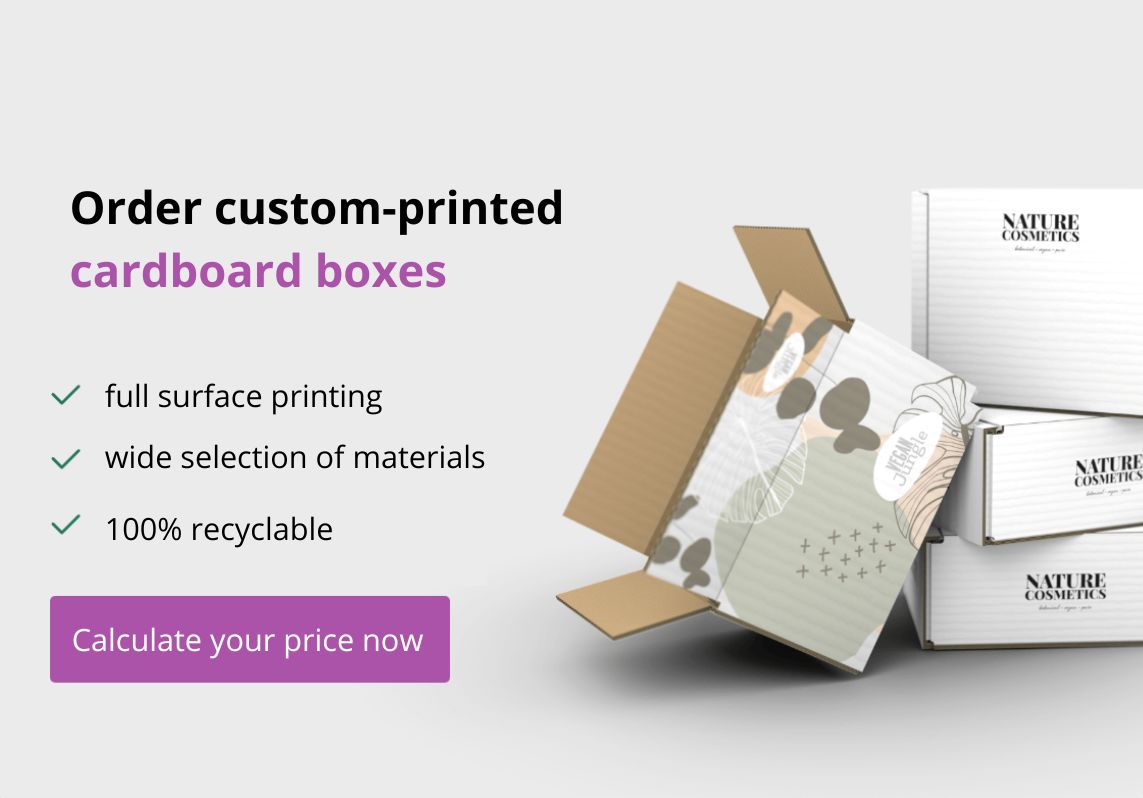Corrugated cardboard: History, manufacture, structure and types of corrugation

Corrugated cardboard enjoys a good reputation in terms of sustainability and environmental compatibility. These are the best reasons to take a closer look at corrugated cardboard. We have compiled everything you need to know about the subject. There might be a few things you didn't know yet.
What is corrugated cardboard?
From pulp to material all-rounder
Corrugated cardboard is a cellulose product that was initially used mainly in the packaging industry. Today, the versatile material is also conquering other areas such as decoration, filing systems and much more. Characteristic of the material is its relative stability with little weight. In addition, corrugated cardboard can be printed and convincingly transports advertising messages on the way to and at the customer.
ICorrugated cardboard owes its name to the combination of at least one smooth and one corrugated web of paper. Here, up to nine paper webs can come together to form a multi-corrugated cardboard. The corrugation in the construction is not accidental.
Grippy or corrugated paper acquires great strength when combined with smooth paper webs. If you like, you are dealing with a lightweight construction system based on paper. The principle of corrugated board was discovered as early as the 19th century.
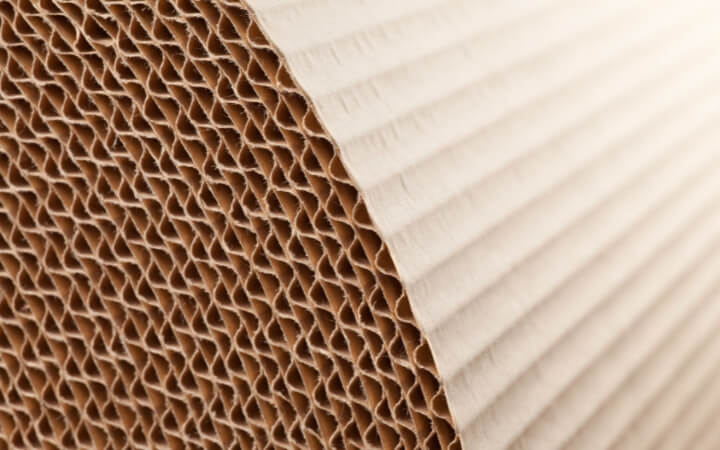
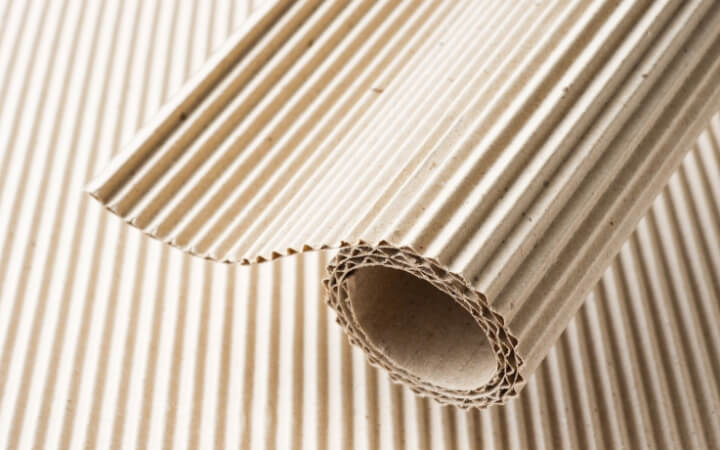
As e-commerce develops, demand for corrugated cardboard continues to rise. Not only in Germany, but worldwide. Contributing to the attractiveness of the material is the fact that the recycling rate for corrugated cardboard is very high. Today, we are already dealing with rates of at least 85% to 100%. The almost closed recycling loop speaks in favor of corrugated paper. From a sustainability point of view, corrugated cardboard is far ahead in terms of value.
In summary, corrugated cardboard has the following primary advantages:
- flexible applicability
- low weight with relative stability
- depending on the type of corrugated board, resistance to
- external influences
- foldability
- closed recycling loop
The history of corrugated cardboard
The first patent on corrugated cardboard construction was granted in England in 1856. At that time, it was for hat liners. This was followed in the USA in 1876 by another patent focusing on an improved paper for packaging purposes. Initially, only single wall corrugated cardboard was patented, but in the early 1880s, multiwall corrugated cardboard was also patented.
At the end of the 19th century, industrial production of corrugated cardboard began in the USA, England and later in Germany. Production machines were constructed. They contributed to the fact that gradually corrugated cardboard boxes began to replace the wooden packaging that had been widely used until then in logistics, transport and storage.
Other types and types of corrugation were created over time at the beginning of the 20th century. Corrugated cardboard increasingly conquered other areas, such as the construction sector as an insulating material. Offset printing and other printing processes for corrugated cardboard made further areas of application in marketing possible, because they could be individually designed.

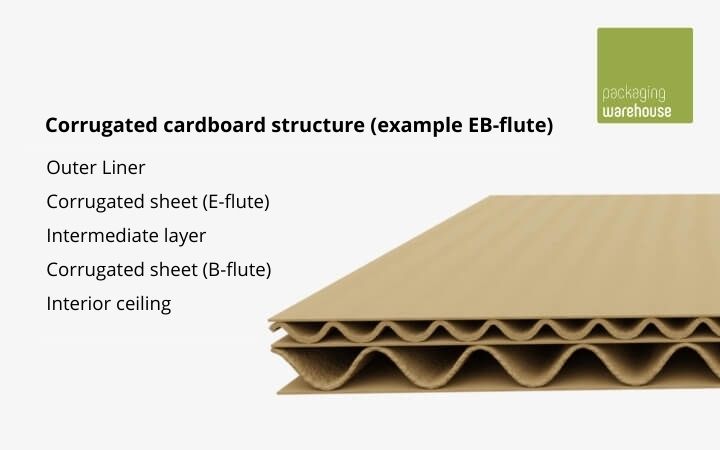
Structure and type divisions
In the packaging industry, single to triple wall corrugated cardboard is mainly used. A double wall corrugated cardboard consists, for example, of the following layers:
- Outer surface (top layer or liner)
- Corrugated sheet
- Intermediate layer
- Corrugated sheet
- Interior ceiling
A further distinction is made between kraftliner and testliner. While kraftliner consists of 80% recycled paper and 20% virgin fibers, testliner is made up of 100% recycled paper. This different structure makes kraftliner more tear-resistant and durable.
The shafts can be of different heights (distance between flute trough and flute crest) and the distance between two flute crests (flute pitch) can be variable. According to this, certain types of corrugations are categorized:
- Rough shafts with a flute height of up to 5 mm and a flute pitch of up to 10 mm
- Medium shafts with a flute height of up to 4 mm and a flute pitch of up to 7.9 mm
- Fine shafts with flute height up to 2.2 mm and flute pitch up to 4.8 mm
- Microwaves with a flute height up to 1.9 mm and a flute pitch up to 3.5 mm
Above and below these numerical values, there are still special flutes which do not play a major role in the packaging sector and the predominant areas of application for corrugated cardboard.
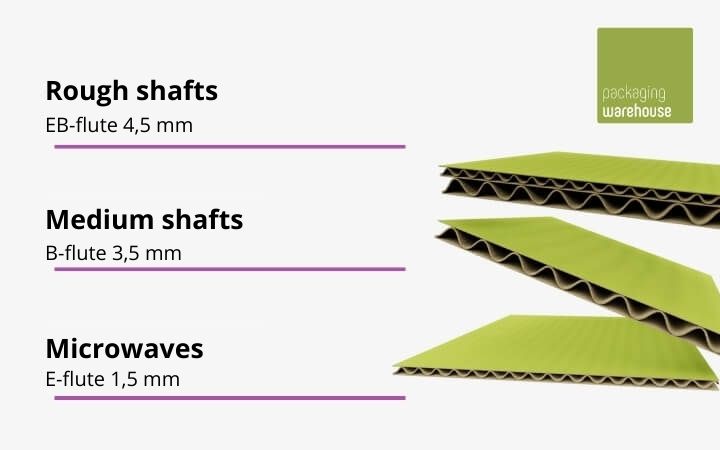
| Designation | Name | Flute pitch | Flute height |
| A | Rough shaft | 8mm to 10 mm | 4mm to 5mm |
| C | Medium shaft | 6,8mm to 7,9mm | 3,2mm to 4mm |
| B | Fine shaft | to 4,8mm | to 2,2mm |
| E | Ultra-fine shaft (Microwave) |
3mm to 3,5mm | 1mm to 1,9mm |
The nomenclature of corrugated cardboard in detail
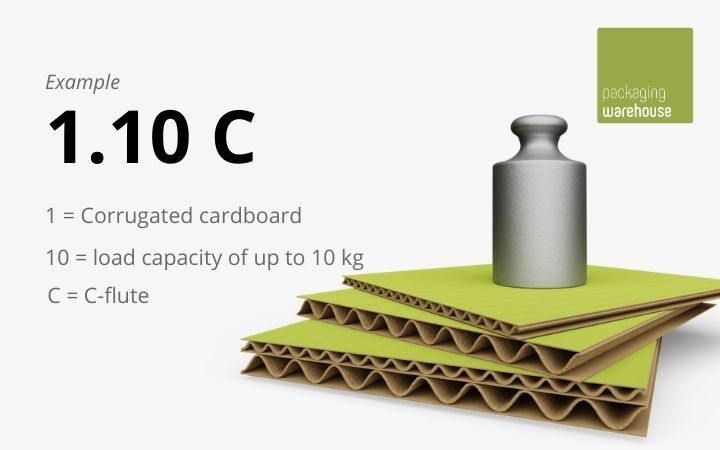
For corrugated cardboard, type classes are marked with letters and sometimes also numbers. The letter classification begins with the letter A for the greater corrugation height and corrugation pitch. This is followed by the following letter designations:
- C-flute for medium corrugation
- B-flute for a fine corrugation,
- D-flute for a fine corrugation
- E-flute for a fine corrugation / microwave
Good to know: There are the further types F, G and N corrugations for tiny corrugation heights and the K corrugation as maxi corrugation above the entire table with a corrugation height above 5 mm. Additional numerical values provide information on the number of corrugations and the load capacity for a package. For example, the designation 1.10 C stands for a single flute C-flute with a load capacity of up to 10 kg.
In the packaging sector, mainly B-flutes, E-flutes and the EB-flute combination are of interest. Different load-bearing packaging can be selected, each of which - assuming uniform distribution - can withstand specific weight classes.
Quality tests for corrugated cardboard according to DIN 55468
Quality requirements for corrugated paperboard are defined by DIN 55468. This DIN standard describes a test system with which corrugated cardboard is tested for
- burst strength
- edge crush resistance
- puncture resistance
Here, DIN standard 55468 specifies grade tables with certain standard values as a quality framework. Grade table 55468-01 is particularly important.
For example, single wall corrugated cardboard 1.01 is specified to have a puncture resistance of 2.5 J and an edge resistance of 3.5 kN/m.
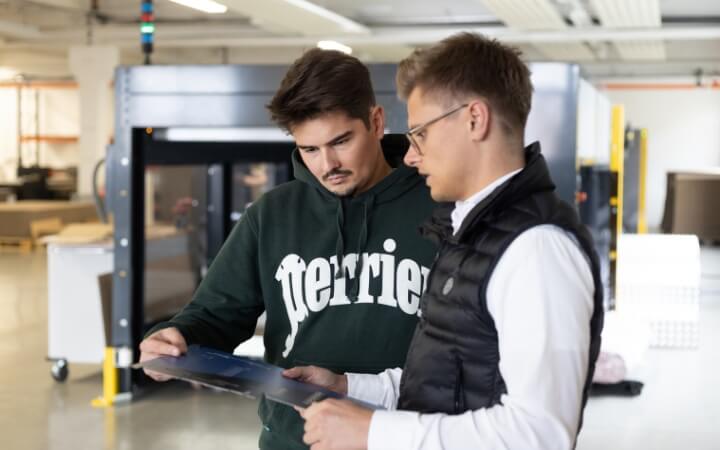
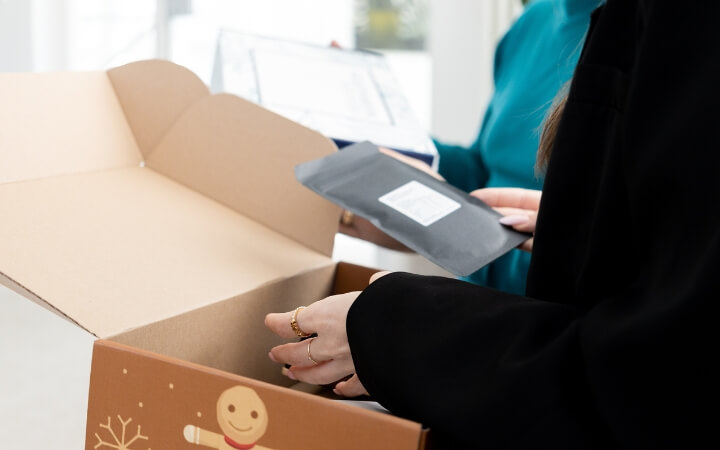
Stability and use of corrugated cardboard
Due to the different types and the use of the different liners, corrugated cardboard proves to be very variable in its stability and usability. In the packaging sector alone, a wide variety of sizes and strengths are conceivable. Corrugated cardboard is used today, among other things, as:
- Shipping boxes and packaging
- Product packaging
- Warehouse storage
- Decorative items
- Insulation material
- Filling material for packaging
- Archive containers
- Furniture
Corrugated cardboard has the most different faces. In packaging, the thinner corrugated cardboards are mainly suitable for packaging products, and the thicker ones for transport packaging.
How corrugated cardboard is made
Manufacturing process of a corrugator
Corrugated cardboard is produced in a corrugator. For production, paper webs are passed through corrugating rolls. The paper is embossed by heat, moisture and pressure. The characteristic sinusoidal corrugation of the corrugated cardboard is produced. Different adhesives are used for bonding the paper webs.
Challenges in the production of corrugated cardboard arise, among other things, from unintentional curvature (warp) of the cardboard. This can occur directly after production and is then usually the result of incorrect machine settings. Improper storage can also lead to warp in various forms later on.
Sustainability aspects
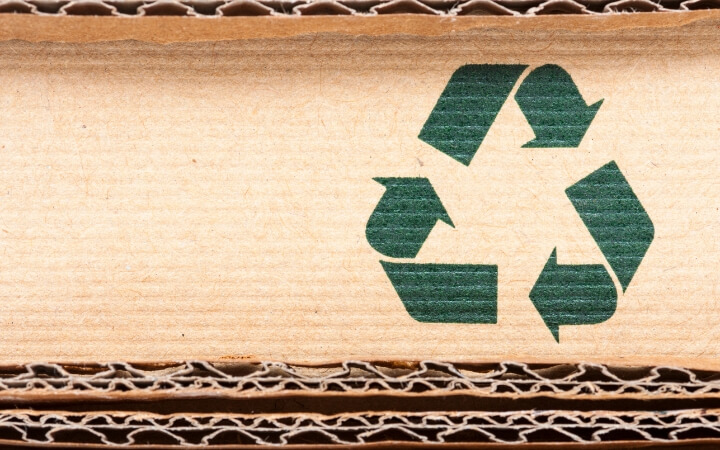
High recycling rates and a low carbon footprint
Corrugated cardboard is a sustainable material. Compared with other materials such as plastic, the closed recycling loop is already a reality today. Between 10 and 25 times the paper fibers can be recycled again. The industry involved is constantly working on production processes that are even more resource-efficient. In particular, this involves further reducing water consumption during production.
Among other things, the carbon footprint for corrugated cardboard has been reduced by 9% since 2015. This puts corrugated cardboard at the top of the list in terms of environmental compatibility and sustainability compared with other materials such as glass, tinplate, aluminum, or plastic.
Corrugated cardboard has its own recycling code with PAP 20. The code can be used to immediately identify the corrugated cardboard as the source material for packaging.
Corrugated cardboard as a marketing tool
Today, corrugated cardboard can be professionally printed individually. As a result, they become excellent brand ambassadors as packaging.
Suppliers and producers in e-commerce and online trade also like to use corrugated cardboard as packaging material to put their own brand in the right light. Printed packaging made of cardboard can be produced in large numbers and serves the marketing needs of a mass market.
These printing processes are available:
- UV digital printing - directly printed corrugated cardboard
- Offset printing - laminated corrugated cardboard
- Flexo printing - directly printed corrugated cardboard
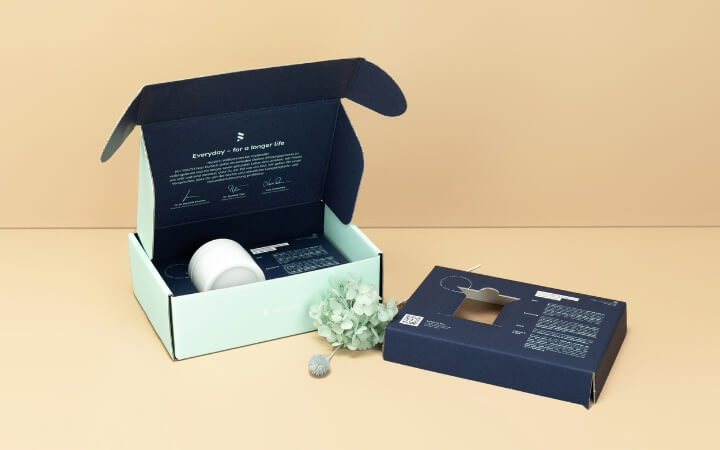



 (1).png)
.png)
.png)
.png)
.png)
 (1).png)
.png)

 (1).png)
.png)
.png)
.png)
.png)
.png)


.png)
.png)



.png)


.png)
.png)
.png)
.png)












.png)


.png)
.png)
.png)
.png)
.png)
.png)
.png)










.png)








.png)











.png)
.png)
























































.png)











.png)

.png)














